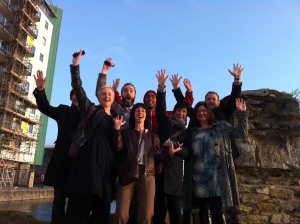Earlier this week, I was in Switzerland at the EMOOCs Summit. I was there, along with Paige Cuffe, to present a collaborative paper entitled ‘Signals of Success and Self-directed Learning’. It seemed a little weird at first, considering that this time last year I had barely cut my MOOC teeth (who had?), and I’d certainly never presented at such a conference before or had a paper published (collaborative or otherwise), so testimony to the power and possibilities that MOOCs and open education can afford and, more importantly for this story, testimony to the power of connection for collaboration and ongoing learning that’s now possible in this new era of learning.

“How do learners define success in a MOOC?”
So what’s the story? As you might know, this time last year I participated in OLDSMOOC and you might be forgiven for thinking that once a MOOC has finished that is it that, the learning is over, but not so because via the OLDSMOOC hashtag and other various social networking activities, connections made in the MOOC continued; the true awesomeness of which was realized when, six months after the MOOC, a group of us responded to a tweet from one of the OLDSMOOC design team wondering if anyone was thinking of submitting a paper to the EMOOCs conference. Hey presto, what do you know; spontaneously and enthusiastically out from the internet emerged six individuals to reflect on their learning and to deliberate what success in a MOOC meant to them. You can read the full paper in the conference proceedings here (p.18) and get more of an insight into our back story in the video below:
https://www.youtube.com/watch?v=wBMmkCBf9tg
The premise of our paper is interesting in that it tries to go beyond institutional evaluations and measures of success to offer an alternative perspective to the pervasive discourse about completion rates and dropouts in MOOCs. Hence, in the conference session entitled ‘Dropouts in MOOCs’, I was heartened by the findings presented by Tharindu Rekha Liyanagunawardena that shows that “MOOC participants are challenging the widely held view of dropout, suggesting that it is more about failing to achieve their personal aims”. Yay!!
On the other hand though, I was a little dis-heartened because although there was a session devoted to connectivist style MOOCs at the conference, cMOOCs seemed to be something of a Cinderella topic. Don’t misunderstand me, there were some excellent presentations given pertaining to cMOOCs (Christine Sinclair, p.245 and Jutta Pauschenwien, p.277) but the overarching concerns of the conference seemed to be xMOOC oriented with concerns about platform provision, production quality and costs and the optimum way forward for higher education dominating.
Not that the conference was all about higher education, indeed one of the four tracks was dedicated to business. I’m glad I opted to go to the panel discussion in this track, ‘MOOCs as a training instruments for employees and partners’, because it really was excellent.
The panelists:
- Donald Clark, Plan-B Learning, UK
- Ralph Wieser, SWISSCOM, Switzerland
- Gregor Erkel, Deutsche Telekom, Germany
- Marcelo Di Pietro Peralta, WIPO, Switzerland
- Yannis Angelis, Fresenius Kabi, Germany
- Carl Dawson, Proversity.org, UK
Certain of their application and with a can-do beta attitude, the panelists were very convincing in aligning MOOCs with vocational skills, competency, CPD and lifelong learning for a corporate market, which was in stark contrast to the presentation entitled ‘MOOCs: an alternative perspective’ given by Debra Humphris of Imperial College, London who didn’t really seem to say what purpose MOOCs might serve and whose institutional policy was to go away and formulate a strategy.
It’s widely agreed that MOOCs are a phenomenon of transition, pointing the way to some future landscape of learning. Right now though, the term seems to signal different things to different people with discussion easily conflating learning contexts, learning cohorts and pedagogies for learning.
In the policy track session, ‘Bringing new challenges to Higher Education’, that I attended on the last day, Gerhard Fischer, Center for Lifelong Learning, University of Colorado noted that many reflections on MOOCs seem to be based on economic and technical perspectives rather than on perspectives of learning science. He suggested that in the main MOOCs are currently geared towards ‘learning about’ and to topics for which there is a known answer, as opposed to ‘learning to be’ and when the answer is not yet known.
Overall, I enjoyed the experience of attending the conference and learning something of the flavor and the fervor of MOOC development and debate, but I think what I was struck by the most was that despite the general nod towards social learning there is a real lack of awareness or understanding for learning in networks and distributed learning environments. Attending the conference as just such a learner (or researcher) made me wonder if I belong to a secret sect because so many people seemed oblivious to these developments.
Image source: Davinia Hernández-Leo. https://twitter.com/daviniahl/status/432906051277836288

This work is licensed under a Creative Commons Attribution-NonCommercial-ShareAlike 4.0 International License.

